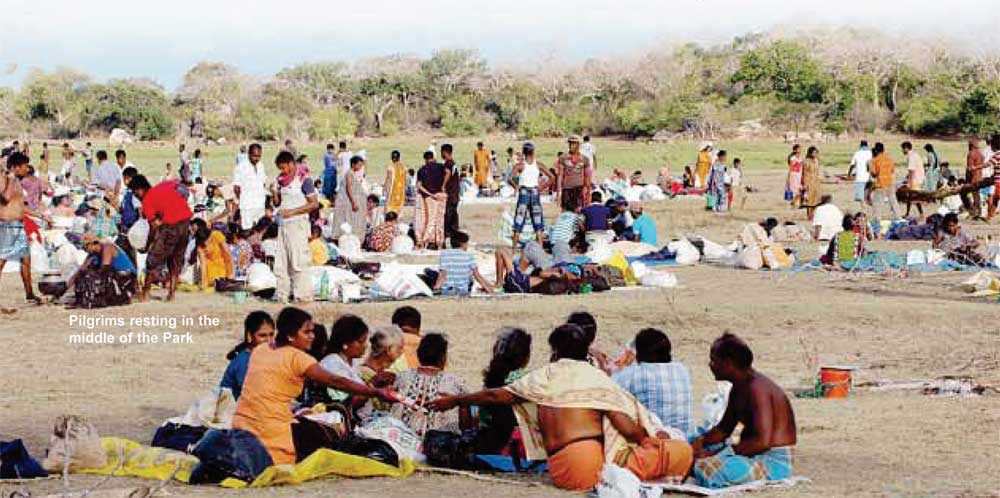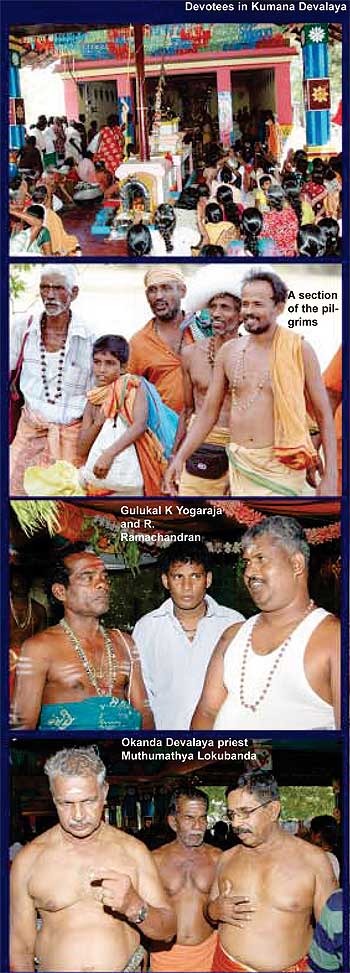
|
|||||||||
|
| |||||||||

The Kataragama Pada Yatra ContinuesPictures by Thusitha ChandrakumaraBy Thursday more than 10,000 Hindu pilgrims had entered the Kumana National Park (the Yala East Sanctuary) on foot to attend the annual Kataragama Festival. The annual event commenced on July 12 from the Park's Okanda Shri Murugan Devalaya and is scheduled to conclude on July 27 in Kataragama with the annual Kataragama Festival. Usually to walk the 100 kilometer range between the Park and the Kataragama Devalaya takes three to 10 days depending the fitness and stamina of the pilgrim. These pilgrims have two places to rest within the Park. None of them will be given the opportunity to return through the Park again, Northern Province Assistant Wildlife Director M.C.G. Rupasinghe said. The Island interviewed a cross section of the pilgrims, most of whom were in high spirits. They were able to bring their loved ones because of the prevailing peace. R. Ramachandran, a financial assistant of the District Planning Secretariat in Ampara, said: "I have been attending this event for the last three years. This year I am with my wife and my nine-year daughter R. Abhikshana. We were joined by seven others." "Unlike other occasions this time we are really free and independent. I am sure that in the coming years there would be a massive number of pilgrims. Everybody loves peace and independence which is clear when one witnesses the number of pilgrims." Madathota Devalaya Priest Keswarapillai Yogaraja says nearly 10,000 devotees were expected from the north and eastern parts of the island this year. "We had about 5,000 devotees for the pooja on the first day. We thank the Government and Park officials for providing all necessities." He said that despite the lure of modern transport, thousands of dedicated pilgrims stick to the ancient practice of journeying to Kataragama on foot. It is called Pada Yatra. Foot pilgrimage or pada yatra as it is called, is just one of many sacred traditions associated with Kataragama that have been passed from generation to generation for centuries. The pilgrimage to Kataragama from Sri Lanka, India and even from central Asia appears again and again in traditional lore in both the Sinhala and Tamil languages. For instance, Sokari, the heroine of the age old ritual comic opera by the same name, originally came to Lanka from India with her foolish spouse Guru Hamy to obtain the blessings of the Kataragama Deviyo that they might conceive a child, a common vow even today. Sri Lankan Hindus believe that Lord Murugan left India long ago to come and settle in Kathir-kamam -the place of light, and love where his vilaiyātal – divine play – continues even to this day.  Hence, pilgrims of today are literally following in the footsteps of a distinguished lineage dating back to antiquity. As old as memory itself, the Kataragama Guru Parampara, the sacred transmission of Kataragama, recognises no boundaries or limits, and has included saints, sages, siddhas and bhaktas of every hue and variety. Pal Kudi Bawa and Yoga Swami of Nallur walked in relatively recent times, but many more have walked unknown and unrecognised for centuries. The route of the Kataragama Pada Yatra traditionally begins in the Jaffna peninsula from where it takes nearly two months to walk to Kataragama. The traditional pada yatra it is said, starts from the ground beneath one's feet, from one's own doorstep or wherever one happens to be when the divine 'call' comes. Courtesy: The Island (Colombo) of Friday, 16 July 2010 Kataragama.org |
|
| Living Heritage Trust ©2023 All Rights Reserved |
